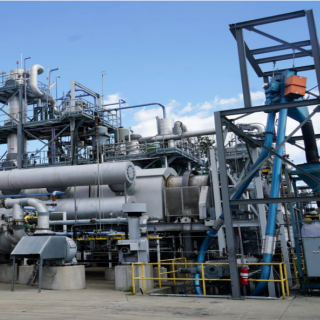After a gas well owned by XTO, a subsidiary of ExxonMobil, exploded on February 15, it continued leaking pollution into the air for three weeks. The word “leak” is deceiving–what came out of the Schnegg well was a 100-foot vertical geyser of smoke, brine, and gases. Powhatan Point, Ohio residents 1.5 miles away could see the initial explosion, and continued hearing the ongoing eruption until XTO capped the well on March 6.
Other locals have started to talk about moving before another disaster occurs in this community–which hosts well over 500 permitted horizontal gas production wells and many pipelines, compressor stations, and other gas infrastructure. 36 homes and farms in a one-mile radius of the XTO site–about 100 people–were evacuated after the explosion. Those within the outer half-mile of that radius–about 30 households–were permitted to return to their homes a full week before XTO capped the well. This community deserves to know what happened and why, what long-term impacts may lie ahead, and how XTO (as well as other operators in the area) will prevent such egregious pollution events in the future.
We know some important details about this disaster. An initial estimate indicated the well emitted 100 million cubic feet of gas per day; such a volume would easily rival the daily amounts emitted from the infamous Aliso Canyon gas leak. We know that the US EPA and Ohio EPA (OEPA) spent just one day onsite collecting air samples before handing over that crucial task to XTO and its contractor, TekSolv.
In a preliminary review of the publicly-available air data, Earthworks has concluded that they are far too limited to in any way support XTO’s conclusion that there weren’t any impacts to air quality or health. Given the intensity and duration of the pollution, and the lack of air monitoring designed to determine health risks, such a stance is laughable at best and deceptive at worst.
OEPA’s limited air testing was based on “grab samples,” lasting just seconds or minutes, of numerous volatile organic compounds (VOCs), pollutants that cause health problems. The results likely show only low concentrations of VOCs because they were taken quickly at a considerable distance from the well site. Weather records indicate that on the day of sampling, the wind was primarily from the north, which may have moved the pollution away from the sampling sites. Also, wind speeds appeared to have been an average of 9 mph with gusts up to 30 mph; VOCs disperse quickly in high winds.
In addition, OEPA and US EPA used a range of monitoring instruments to collect samples from several locations. But the results from these methods lump all VOCs together into one category–making it impossible to determine which ones were in the air and subsequently any associated health impacts.
In addition, pollutant levels were measured using methods designed to determine only whether there was an explosion or direct exposure risk for workers near the site. Most notably, this sampling detected hydrogen sulfide, a gas that causes a range of health problems (like nausea, dizziness, and headaches) at low concentrations and death at high concentrations. However, the sampling methods were inadequate to determine whether the pollution might cause health impacts for the community either because of immediate or longer-term exposures.
To date, XTO’s contractor TekSolv has released only one day of sampling data to the public, and that was in the form of a summary of measurements taken nearly one week after the explosion. Supposedly TekSolv monitored every day, which means more than 20 days of results, along with raw data, are still missing from public view.
Earthworks responded to several requests from concerned locals and on March 3–while the well continued gushing–visited Powhatan Point to learn more. Using infrared optical gas imaging (OGI), an Earthworks thermographer documented that the pollution from the broken wellhead was not limited to the massive visible plume, but in fact extended hundreds of feet higher and traveled several miles beyond the site. During that visit and in the weeks since, Earthworks collected additional information in the form of residents’ observations, including their reports of health impacts. Besides noise, stress and fear created by the explosion and the unknowns surrounding the uncontrolled emissions, locals have reported headaches, dizziness, and nosebleeds.
What’s more, on top of the air pollution created by the XTO explosion and leak, residents of Powhatan Point encounter harmful oil and gas pollution on a daily basis from the hundreds of gas facilities in their county alone. These include significant emissions Earthworks documentedat three compressors on March 3. Like the millions of Americans who live near oil and gas development, Powhatan Point residents are routinely exposed to chemicals and compounds associated with respiratory and cardiac conditions, reproductive harm, and cancers, and other health impacts.
What we still don’t know is what precisely was in the air during the three weeks before XTO announced they capped the well, in what amounts, and how those exposures were distributed over the rolling ridges and valleys of this community. We question what might be the health impacts of the cocktail of low-level, multi-week doses of assorted VOCs. What will be the long-term health outcomes for those with these exposures, and what resources will be made available to the impacted community to address any future medical problems? We also await assurance about the success of the well capping–have the regulators used OGI to ensure no invisible emissions persist? The day after XTO flared off the gas in order to cap the well–creating a “ball of fire” seen for miles–the gas company sent the remaining four displaced families back to their homes, but deemed it necessary to first conduct room-by-room indoor air monitoring. Will XTO confirm that this testing has been done and share these results with the public?
We’re calling on the regulators to do the job they’re mandated to do. The public needs a complete, in-depth investigation of this disaster and answers to these questions. The investigation must begin with exactly why this occurred and what operators like XTO must do to avoid it happening at other sites. The inquiry should make publicly available all air monitoring data collected by the regulators, XTO, and their contractor TekSolv. Earthworks fileda formal written complaint with both OEPA and ODNR on March 11 and awaits a response.
This blog was co-authored with Nadia Steinzor.



